Results Are In: Creative Quality Drives the Most Sales
We looked at one of the most comprehensive advertising studies done in the last decade to glean nuggets of wisdom for marketers—here’s what we found.
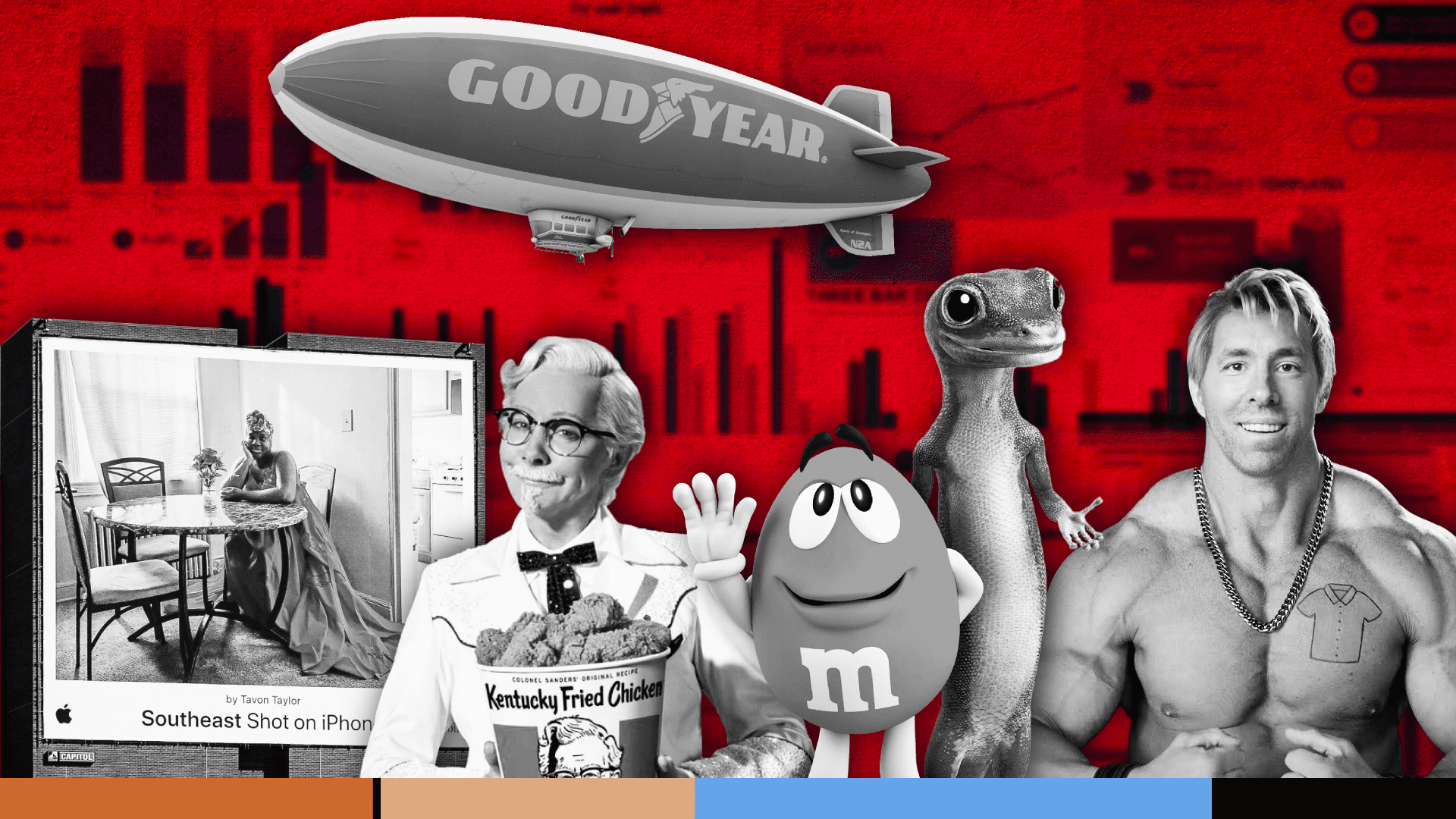

If you’re like most marketers, you’ve probably spent a lot of time scratching your head and wondering what makes an ad campaign effective.
Is it the reach? The precision audience targeting? The resonance of the creative? The timing? Repeat messaging?
We decided to let the research speak for itself on this one.
In one of the most comprehensive advertising industry analyses ever, NCS analyzed the results of 500 marketing studies and another 863 brand campaign studies published over two quarters in 2016 and 2017. The meta-analysis focused on the five key drivers of ad effectiveness:
- creative
- reach
- targeting
- recency
- context
This report evaluates the sales contribution of these five key drivers, including a separate study that examines the reach of TV and digital for nearly 900 cross-media campaigns.
After assessing the results ourselves to see what nuggets of golden wisdom we could glean from this big data dive, here’s an overview of the essential takeaways from the study.
The Five Key Drivers Measured in this Study
Admittedly, an infinite number of confounding variables might influence consumers to hand over their credit card number (or not). But as marketers, we’d drive ourselves crazy trying to factor in every possible element and circumstance that might affect an ad’s performance.
That’s why marketers focus on five of the most impactful drivers of ad effectiveness over which we actually have some control: creative quality, reach, targeting, recency, and context.
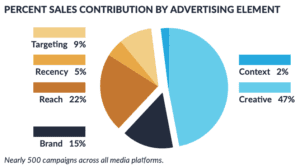
Creative (47% sales contribution)
Feats of visionary genius and the power of storytelling come together in creative. Of course, we all know that a great story can captivate an audience, but it’s often difficult to quantify what makes a creative idea good or bad—especially if creativity isn’t your forte.
But viewers know intuitively when creative strikes their fancy, which translates into tangible performance quantifiable in dollars and cents.
Reach (22% sales contribution)
In the age of digital media, brands hope to reach consumers through televisions, computers, phones, and any other number of devices. Reach, not to be confused with targeting, is the number of people a given ad or message touches. Seasoned marketers know reach on its own isn’t enough to yield impressive ROI, but combined with the other drivers, it’s a powerful factor in driving sales.
Targeting (9% sales contribution)
Ad targeting enables brands to ensure their message reaches the right people at a time when those consumers are most likely to purchase. One of the most tremendous benefits of digital media is being able to micro-target an ideal audience with pinpoint accuracy. While reach gets your message out to a wide audience, targeting focuses your message on an identified group of people, so you don’t waste time and money on irrelevant messages.
Recency (5% sales contribution)
Timing is everything in the world of advertising—especially with digital media. Ads need to be displayed not only when users are most likely to purchase but also when they’re most likely to remember it. For example, if a user views an ad for a new car on Monday and doesn’t even think about the car until Friday, that ad has lost its power to influence them.
Context (2% sales contribution)
Finally, context is the environment in which your ad appears—and it can make or break an advertisement’s effectiveness. Generally speaking, brands should place ads in high-quality, brand-safe environments and avoid areas with excessive advertising clutter. Advertisements that appear in the proper context will have a much higher chance of resonating with viewers, increasing their likelihood of influencing them to take action.
Results Are In: 5 Key Takeaways For Businesses
1. Creative quality is the primary factor for driving sales.
The study was clear—creative quality is the most crucial factor for driving sales. Reach, context, recency, and targeting are all ineffective if the creative is uninspired, so getting your creative right is key to your campaign’s success.
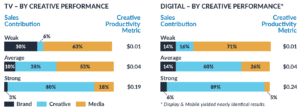

When it comes to the quality of the creative, weak creative leaves media to pick up the slack with 63% of the sales contribution—that’s true for both TV and digital campaigns.
This relationship is reversed when the creative is solid and incremental sales are higher—media has a much smaller contribution to sales, which 80% of the sales contribution going to creative for TV and 89% for digital.
2. Most campaigns have room for improvement when it comes to targeting.
Less than half of all campaigns are doing an excellent job of targeting buyers of the brand or category. The study found that 53% of all TV and digital campaigns were off-buyer targets. When a campaign is Off-Buyer Target, the creative must work harder to drive sales.


3. Digital creative is inconsistent compared to TV ads.
TV ads generally have consistently high-quality creative—as opposed to digital ads, which have a wider range of quality, including both much higher and much lower. This is likely because TV ad production traditionally tends to follow more rigorous brand standards than digital campaigns (and because brands often work with larger budgets when it comes to TV).
4. TV still offers the best reach.
For large cross-media campaigns, reach still comes primarily from television. The average reach for TV in a typical cross-media campaign is 58% of the target, vs. just 2% for the digital portion. Only when digital campaigns are “large,” meaning reach greater than 60%, do we see that digital does sometimes add incremental reach.
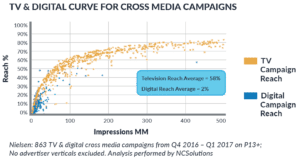

5. You still have to consider the consumer.
Understanding consumer purchase cycles and timing advertising closer to purchases can boost sales dramatically. For instance, products most often bought on a Saturday or Sunday, advertising on Thursday or Friday dramatically affects sales. Advertisements that run on Thursdays outperform Fridays, and together, they deliver almost three times more incremental sales lift than ads running on other days of the week.
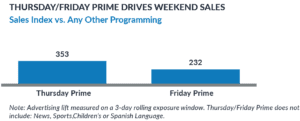

Hey Helps Brands Fine-Tune Their Approach
These findings provide plenty of insight into the effectiveness of TV and digital campaigns, but putting it all to use is a different story. With the correct data, marketers can hone their media investments and creative executions for maximum ROI—if they have creative resources to do it right.
At Hey, we’re passionate about helping brands make intelligent decisions with data-driven insights. We combine out-of-this-world creative with data science to help brands better identify audiences, get insights into trends and behaviors, and create more effective campaigns.
Contact us today to learn more about how Hey can optimize your marketing strategy for maximum success with industry-leading creative.


Comments are closed.